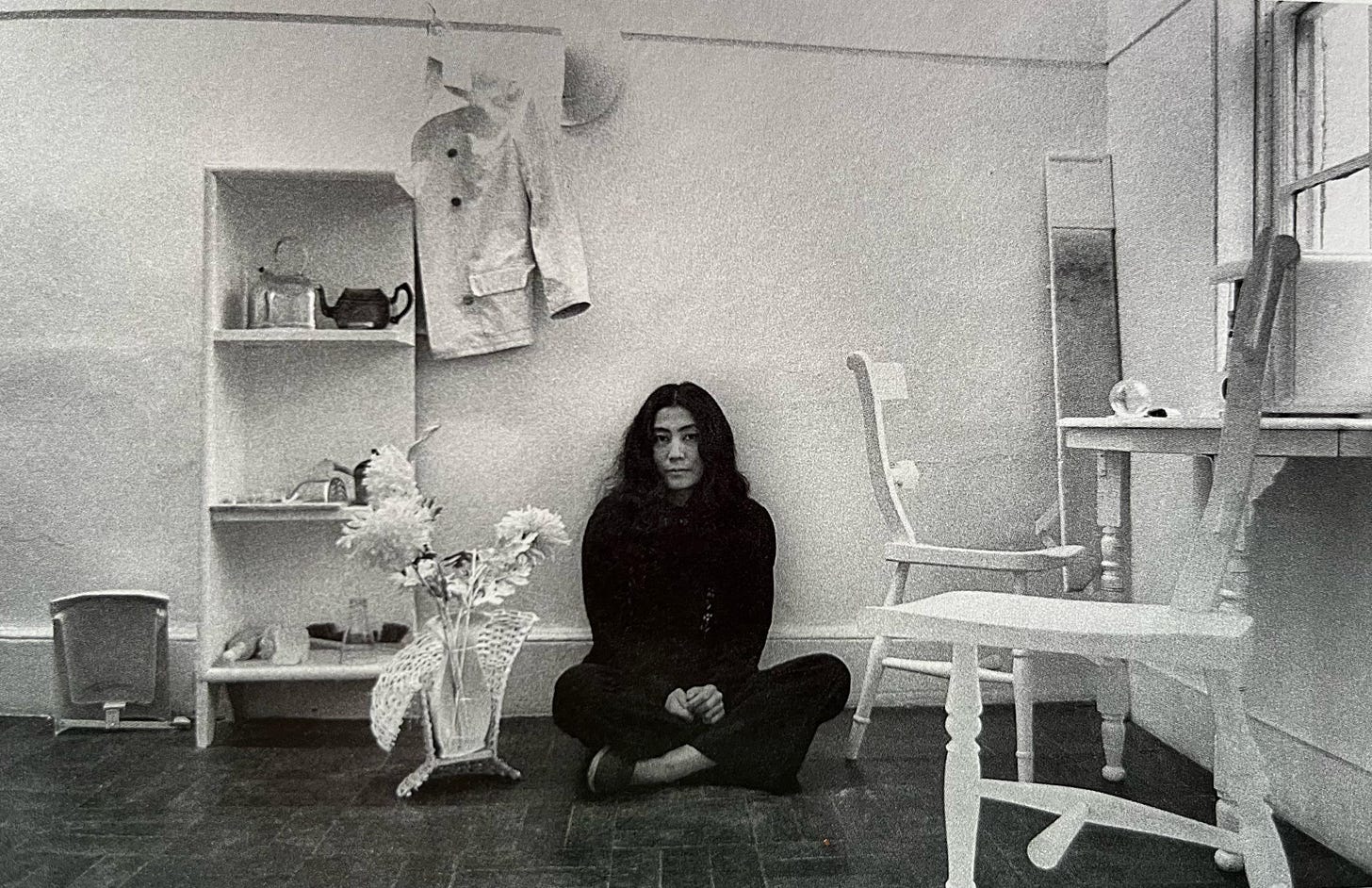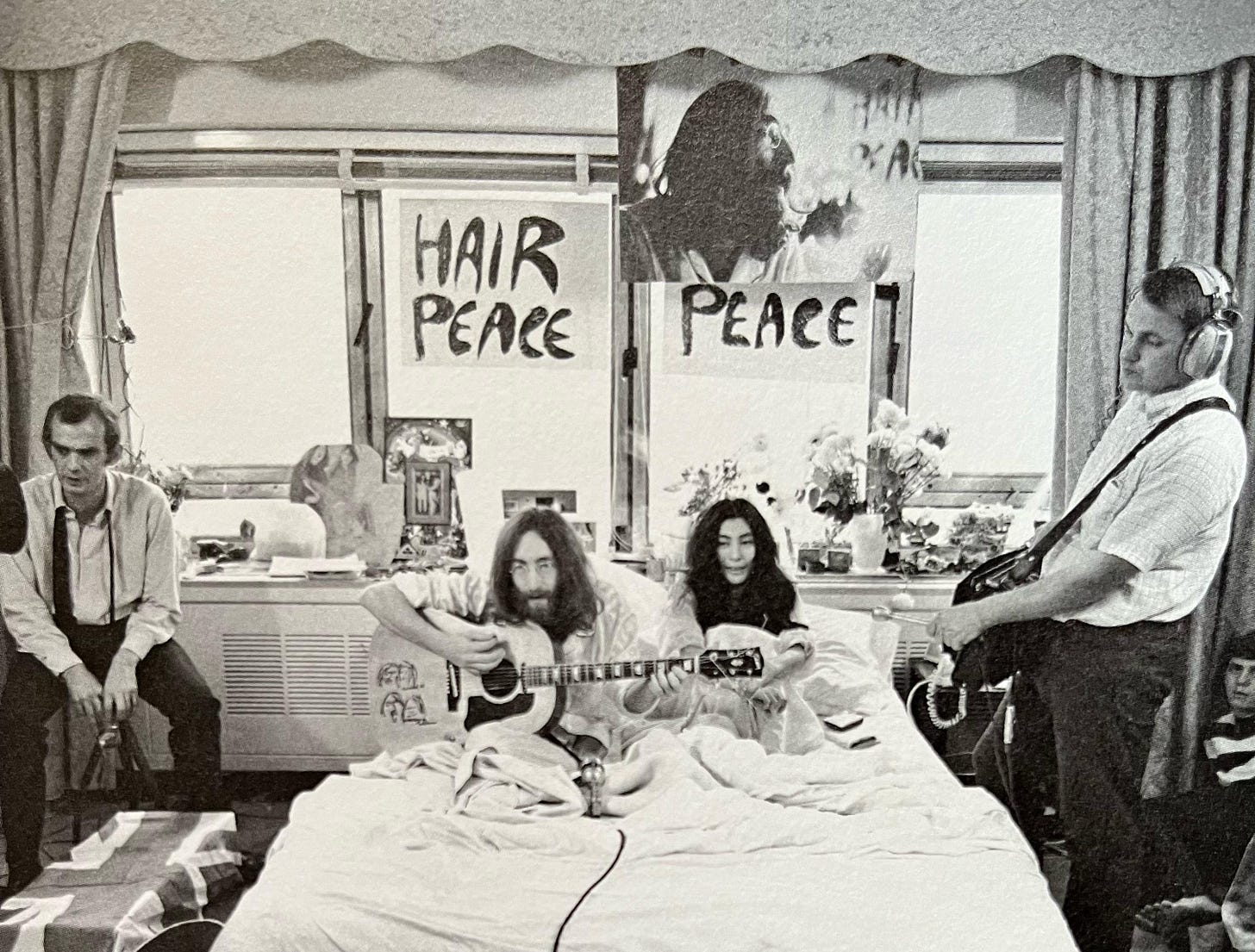“Hate is just an awkward way of love. We spit on people when we want to kiss them. We hit them when we only want to be held. We talk about misunderstanding and hurt. But how could we hurt or misunderstand each other when we are so much alike, when we are the only people who share this world for this decade, this year, this day, under the same sky?” Yoko Ono Aug. 73
I'm heading to Berlin. Another day, another show. We will be dancing through the darkness of this world, in a city full of hedonism—a sanctuary for those seeking freedom, understanding, and love. When I first came here in the early 2000s, everything revolved around the euphoric celebration of parties and the people who made them happen. Now, this Sin City is saturated with like-minded souls, yet this time, I am not a raver but a performer. We are playing a gig at a festival, and before we hit the stage, I discovered that Yoko Ono's exhibition, titled MUSIC OF THE MIND, is currently on display. I could genuinely use some hope right now, and there is no one better than Yoko who knows how to inspire a bit of promise in this fucked up world. Let’s go!
As I step into the beautiful Gropius Bau museum, the first thing that catches my eye is a large banner suspended from the ceiling, proclaiming, "PEACE IS POWER." It's impressive, I pause and reflect, thinking to myself - We could imagine peace in a time of conflict ... right?
Write your wish and hang it on the wish tree. Reach out to your mother, even if she isn’t in your life. Engage in a game of chess where all the pieces and all the board squares are white—play as long as you can remember where all your pieces are. Watch close-ups of nude butts in the black and white film No. 4 Bottoms. My favourite so far, it reminds you that we all share a commonality; no matter our status —we each have an ass. Explore the Instruction paintings through your imagination or physical enactment, and create your own art. Can you envision spending an entire day following these instructions? I have her book Grapefruit at home - the monument of conceptual art of the 60s - and now I'm seriously considering giving it a try.
BLOOD PIECE
Use your blood to paint.
Keep painting until you faint.
Keep painting until you die.
1960 spring



The film Fly captivates my attention with its striking imagery- a nude female body, and a fly flying around which is in focus, and Ono's voice buzzing of an insect as a soundtrack. When you watch the fly, you forget about the body.
Is the body dead or alive?
"This whole idea of a male society was based on the fact that women shut up, but shutting up is a death in a way. So we were always kind of pretending to be dead."
Then there is a room with the boat, a piece titled Refugee Boat, where you can grab a blue marker and are encouraged to write a message of solidarity and peace. By now, the space has transformed into a stunning canvas of blue, resembling a vast ocean.
And, of course, one of her most renowned works, Cut Piece (video), where the members of the audience are invited to cut the performer's clothing. This piece certainly seemed to inspire Marina Abramović... I love this work - Cut Piece, iconic stature in the history of performance art and proto-feminism. It sparked an intense media frenzy. Back then, journalists were super hostile to performance art, and especially to women doing strange things on stage.
The whole space is an interactive playground where you can revisit all of her previous works, and she encourages your participation. Conceptual art may not resonate with everyone, often provoking a sense of intellectual panic. You might find yourself questioning the pieces, asking why you should engage with them, why she can't perform the experience for you instead. However, if that's your mindset, perhaps you've come to the wrong exhibit.
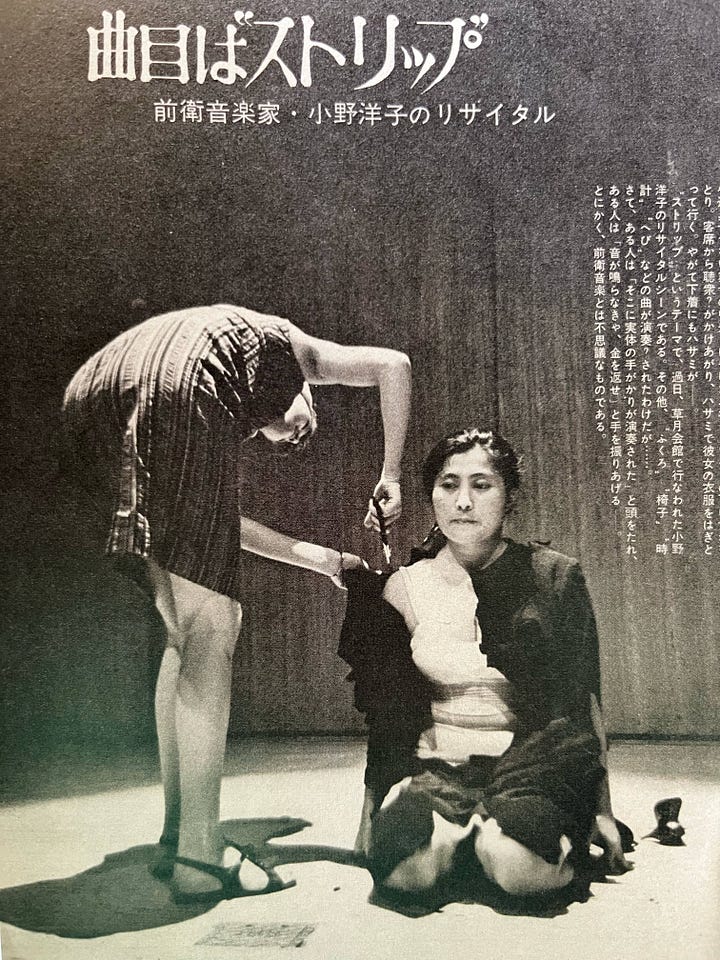
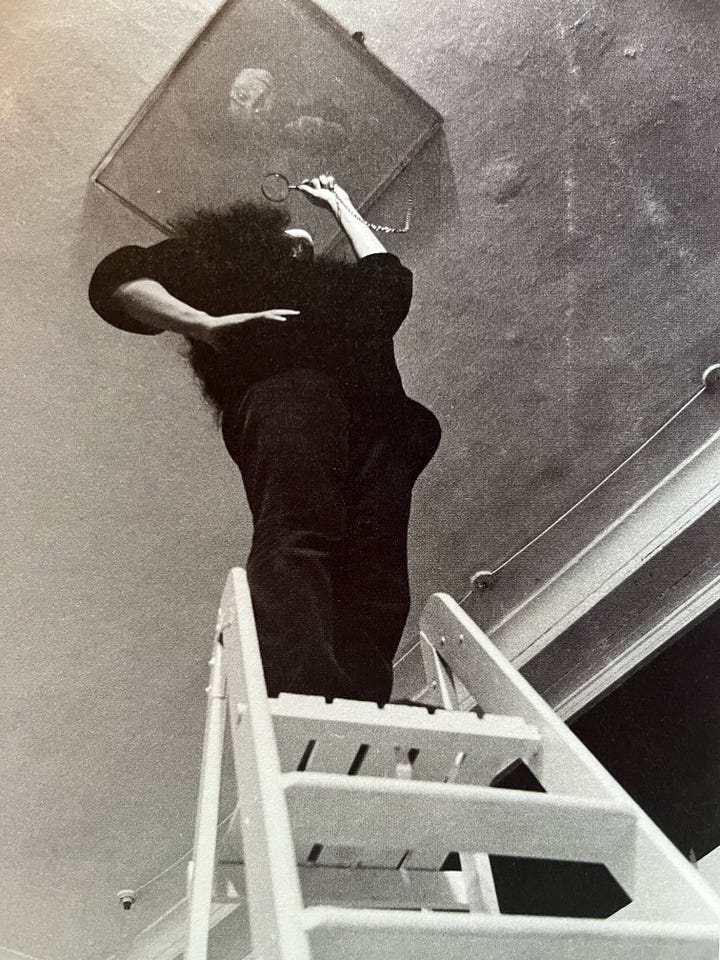
I believe that "Music of the Mind" is extremely relevant right now. I also believe that the exhibition marks a significant "comeback" for Yoko Ono, allowing audiences to finally recognise her groundbreaking artistry and the hard work she has put in over the years. It feels like a long-overdue moment for people to appreciate her after enduring so much negativity, fueled by hate, racism, sexism, and misogyny that have been disturbingly perpetuated by the media and accepted by many.
I've always been taken aback by the animosity directed at Yoko Ono. It's disheartening to see comments that mock her talent, treating her voice as a punchline rather than appreciating it as a form of art. How can anyone have such negative feelings towards someone who genuinely advocates for peace?
"People say that for the last five years I had been a hate object of the world. It was sort of fashionable to put me down. You don't hurt me though, because I know you and I love you. I can take hatred, because I don't believe that people are capable of real hate. We are too lonely for that. We vanish too quickly for that. Do you ever hate a cloud? How could anyone hate people who are on their deathbeds? That's where we all are since the day of birth." Aug. 73
Well, it’s not surprising that female artists face backlash. Historically, women have often been criticised regardless of their accomplishments. The rock and roll scene of the 60s and 70s was largely male-dominated, with men making up the vast majority of musicians, DJs, and record executives. Women were invisible in the industry. Did you know that there was a bizarre belief that women couldn't biologically rock? I know... It’s absurd, and while we’d like to think that times have changed for the better, women continue to face backlash today.

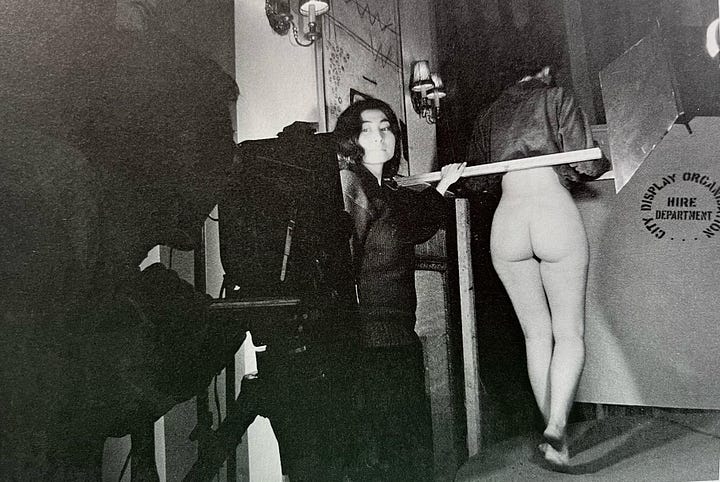
Yoko Ono, to me, is a unique figure in the art world; she has this aura of a female art guru, mystical and eccentric. Her character is quite fascinating, she is present but absent. There is an enigmatic quality to her, hard to fully comprehend because she is unpenetrable. After enduring harsh judgments, she remains remarkably composed and self-possessed. It takes enormous strength to stay calm and collected when the world is pointing a finger at you.
Throughout her life, she faced some challenges. She escaped the devastation of World War II in Japan and navigated the complexities of both Eastern and Western cultures. She was committed to a psychiatric hospital and attempted to commit suicide. Her second husband kidnapped her eight-year-old daughter and took her into a cult; (they were reunited 27 years later). As if that wasn’t enough, she witnessed the murder of the person she loved, all while facing relentless scrutiny and hostility from the media and the public.
I think you can tell that her work is a way of survival; her work has always been about reshaping reality and envisioning a "better world" through the power of words and the use of imagination. She ensures that art is accessible to all. She incorporates poetry into people's ordinary routines, reconnects with others, makes art simple and interactive, makes art-the-everyday, and last but not least, uses global celebrity for social causes. She has been trying to change the world and is heavily criticised for it.
Picture New York in the late 1950s and early 1960s, just 15 years after Japan attacked Pearl Harbor. For a Japanese woman arriving in America during this period, it must have been very intimidating, as both racism and sexism were kicking in. But nothing is more important for her than art. She steps right into a world where the avant-garde movement is in full swing, yet is profoundly dominated by men. This period marks a significant transition from traditional painting to conceptual art—a wake-up call following the war. Artists, musicians, writers, and poets are reinventing their understanding of what Art can be. And here they are - John Cage, David Tudor, Toshi Ichiyanagi, Nam June Paik, La Monte Young, Yoko Ono, and many others. She quickly becomes involved with the avant-garde art scene, and artists are very much influenced by her work. Before her, there was a depiction of reality; with her, there was the art of the mind.
"First I was a bitch who broke up the Beatles, then I was upgraded to a witch."
It is impossible to tell Yoko's story without mentioning John Lennon. For many, she broke up the Beatles, some even go as far as to suggest she played a role in John Lennon's tragic death. Yet, the whole narrative fails to address Lennon himself, as is often the case. It’s easy for fanatics to fixate on these iconic male figures, their fame often allows their actions to be overlooked, reinforcing the stereotype of male genius. Unfortunately, very few took the time to explore John Lennon's actions, and based on my research, I've uncovered several troubling dimensions of his character. If I were to question anyone, it would be him, as the contradiction of a violent man advocating against violence is remarkably ironic.
The two of them crossed paths and fell in love, sparking an intense romance that quickly drew the attention of the public. The constant media presence hurts her art. As an artist, she finds her freedom increasingly constrained. It's important to remember that she had already established her career before meeting him. He was completely captivated by her, pouring all his love into their relationship. He dragged her along to Beatles recording sessions, unable to be apart from her; the tension was visible among the band members, who wondered why he insisted on bringing his girlfriend to every session. But John didn't care. He was head over heels in love.
Yes, it's the 60s & 70s, and everyone is taking shit loads of drugs including John and Yoko. The Beatles, in particular, relied on so much amphetamine to keep up with their demanding schedule of performances. There is a story regarding Yoko and John's drug dealer; apparently, he was cutting their heroin with baby powder, which resulted in a less potent substance, and since John and Yoko preferred to avoid needles, they survived through the heroin crisis/addiction of that era.
Ultimately, Lennon made the bold decision to leave the Beatles behind. His focus shifted entirely towards Yoko, drawn by her artistic vision and a shared passion for creating impactful art. Many criticised them for their intimate connection, perceiving their relationship as a public statement while they actively campaigned against war.
Around 1968, Yoko Ono decided to form the PLASTIC ONO BAND —"that would never exist" but could accommodate anyone who wanted to play. The band's creative output emerged from the earlier collaborations between Ono and Lennon, blending music with her performance art works. Later in his solo career, John Lennon crafted the iconic and best-selling single "Imagine." The song was designed to inspire listeners to envision a world filled with peace, with much of its lyrical depth and content being influenced by Yoko Ono's artistic vision.
When things became strained between them, Yoko pursued John to have an affair with May Pang, their assistant. A couple of years ago, a documentary called "Lost Weekend" was released. May Pang, who was in her early twenties and incredibly in love with John, provides her perspective on the events. There are several ways to interpret this documentary. Take a look. For my part, I'm not entirely sure about it. Lennon and Ono have both stated in interviews that their separation was necessary. They both knew that they would eventually find their way back to each other.

“Yoko is still one of the most radical musicians today. She is so ahead of her time.” Kim Gordon
Ono persisted in her musical journey, exploring a range from avant-garde to pop, gradually establishing herself as a rock legend and a significant figure in pop culture. Today, at the age of 91, she is the most well-known artist from the experimental avant-garde of the 1960s. Her belief in peace and love makes her a gift to the world.
Thank you, Yoko Ono.
We had a great gig and after party. I left Berlin thinking about Yoko Ono's work. Perhaps all we have left is our imagination. When you're going through a difficult time and can't change it, you can sit down, look up at the sky, and imagine something better than what you're experiencing. It may sound like pretentious hippy shit, but it would be nice to have some peace right now, or at least IMAGINE
*All images featured in this article come from my personal copy of “Yoko Ono, One Woman Show 1960-1971,” published by the Museum of Modern Art, New York. Additionally, some photographs were taken during my visit at the exhibition Music of The Mind at the Gropius Bau museum, Berlin.




